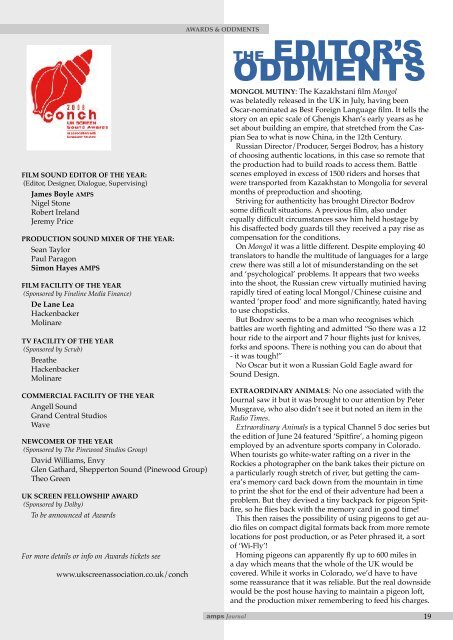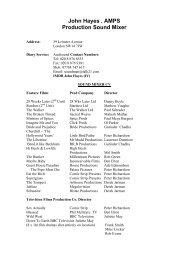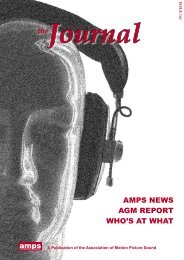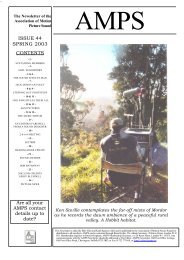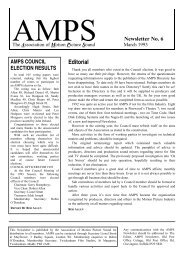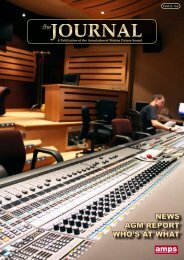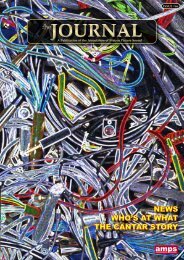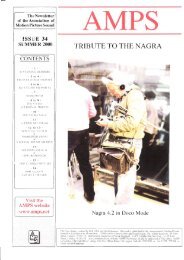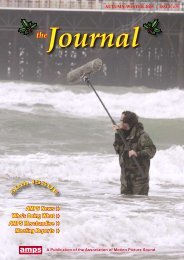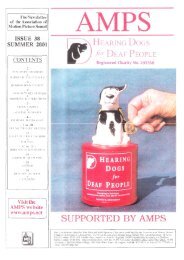amps NEWS WHO'S AT WHAT CONCH AWARDS 2008
amps NEWS WHO'S AT WHAT CONCH AWARDS 2008
amps NEWS WHO'S AT WHAT CONCH AWARDS 2008
You also want an ePaper? Increase the reach of your titles
YUMPU automatically turns print PDFs into web optimized ePapers that Google loves.
FILM SOUND EDITOR OF THE YEAR:<br />
(Editor, Designer, Dialogue, Supervising)<br />
James Boyle AMPS<br />
Nigel Stone<br />
Robert Ireland<br />
Jeremy Price<br />
PRODUCTION SOUND MIXER OF THE YEAR:<br />
Sean Taylor<br />
Paul Paragon<br />
Simon Hayes AMPS<br />
FILM FACILITY OF THE YEAR<br />
(Sponsored by Fineline Media Finance)<br />
De Lane Lea<br />
Hackenbacker<br />
Molinare<br />
TV FACILITY OF THE YEAR<br />
(Sponsored by Scrub)<br />
Breathe<br />
Hackenbacker<br />
Molinare<br />
COMMERCIAL FACILITY OF THE YEAR<br />
Angell Sound<br />
Grand Central Studios<br />
Wave<br />
NEWCOMER OF THE YEAR<br />
(Sponsored by The Pinewood Studios Group)<br />
David Williams, Envy<br />
Glen Gathard, Shepperton Sound (Pinewood Group)<br />
Theo Green<br />
UK SCREEN FELLOWSHIP AWARD<br />
(Sponsored by Dolby)<br />
To be announced at Awards<br />
For more details or info on Awards tickets see<br />
www.ukscreenassociation.co.uk/conch<br />
<strong>AWARDS</strong> & ODDMENTS<br />
THE EDITOR’S<br />
ODDMENTS<br />
MONGOL MUTINY: The Kazakhstani film Mongol<br />
was belatedly released in the UK in July, having been<br />
Oscar-nominated as Best Foreign Language film. It tells the<br />
story on an epic scale of Ghengis Khan’s early years as he<br />
set about building an empire, that stretched from the Caspian<br />
Sea to what is now China, in the 12th Century.<br />
Russian Director/Producer, Sergei Bodrov, has a history<br />
of choosing authentic locations, in this case so remote that<br />
the production had to build roads to access them. Battle<br />
scenes employed in excess of 1500 riders and horses that<br />
were transported from Kazakhstan to Mongolia for several<br />
months of preproduction and shooting.<br />
Striving for authenticity has brought Director Bodrov<br />
some difficult situations. A previous film, also under<br />
equally difficult circumstances saw him held hostage by<br />
his disaffected body guards till they received a pay rise as<br />
compensation for the conditions.<br />
On Mongol it was a little different. Despite employing 40<br />
translators to handle the multitude of languages for a large<br />
crew there was still a lot of misunderstanding on the set<br />
and ‘psychological’ problems. It appears that two weeks<br />
into the shoot, the Russian crew virtually mutinied having<br />
rapidly tired of eating local Mongol/Chinese cuisine and<br />
wanted ‘proper food’ and more significantly, hated having<br />
to use chopsticks.<br />
But Bodrov seems to be a man who recognises which<br />
battles are worth fighting and admitted “So there was a 12<br />
hour ride to the airport and 7 hour flights just for knives,<br />
forks and spoons. There is nothing you can do about that<br />
- it was tough!”<br />
No Oscar but it won a Russian Gold Eagle award for<br />
Sound Design.<br />
EXTRAORDINARY ANIMALS: No one associated with the<br />
Journal saw it but it was brought to our attention by Peter<br />
Musgrave, who also didn’t see it but noted an item in the<br />
Radio Times.<br />
Extraordinary Animals is a typical Channel 5 doc series but<br />
the edition of June 24 featured ‘Spitfire’, a homing pigeon<br />
employed by an adventure sports company in Colorado.<br />
When tourists go white-water rafting on a river in the<br />
Rockies a photographer on the bank takes their picture on<br />
a particularly rough stretch of river, but getting the camera’s<br />
memory card back down from the mountain in time<br />
to print the shot for the end of their adventure had been a<br />
problem. But they devised a tiny backpack for pigeon Spitfire,<br />
so he flies back with the memory card in good time!<br />
This then raises the possibility of using pigeons to get audio<br />
files on compact digital formats back from more remote<br />
locations for post production, or as Peter phrased it, a sort<br />
of ‘Wi-Fly’!<br />
Homing pigeons can apparently fly up to 600 miles in<br />
a day which means that the whole of the UK would be<br />
covered. While it works in Colorado, we’d have to have<br />
some reassurance that it was reliable. But the real downside<br />
would be the post house having to maintain a pigeon loft,<br />
and the production mixer remembering to feed his charges.<br />
<strong>amps</strong> Journal 19


